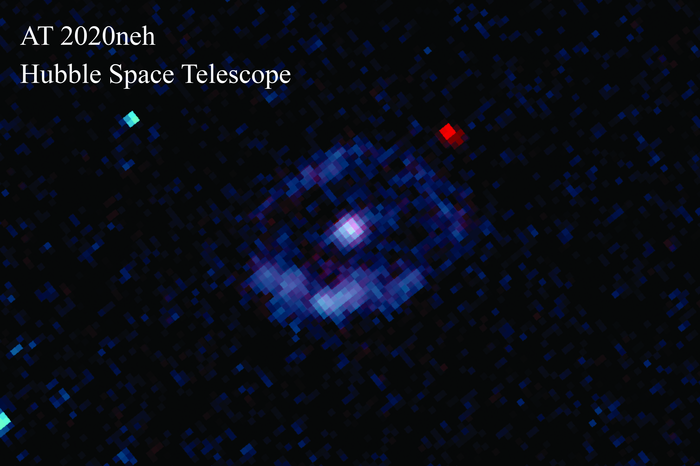Reviewed by Alex SmithNov 11 2022
An intermediate-mass black hole prowling unnoticed in a dwarf galaxy exposed itself to astronomers when it ate up an unfortunate star that drifted too close.
 Astronomers discovered a star being ripped apart by a black hole in the galaxy SDSS J152120.07+140410.5, 850 million light years away. Researchers pointed NASA’s Hubble Space Telescope to examine the aftermath, called AT 2020neh, which is shown in the center of the image. Hubble’s ultraviolet camera saw a ring of stars being formed around the nucleus of the galaxy where AT 2020neh is located. Image Credit: NASA, ESA, Ryan Foley/UC Santa Cruz.
Astronomers discovered a star being ripped apart by a black hole in the galaxy SDSS J152120.07+140410.5, 850 million light years away. Researchers pointed NASA’s Hubble Space Telescope to examine the aftermath, called AT 2020neh, which is shown in the center of the image. Hubble’s ultraviolet camera saw a ring of stars being formed around the nucleus of the galaxy where AT 2020neh is located. Image Credit: NASA, ESA, Ryan Foley/UC Santa Cruz.
The shredding of the star called a “tidal disruption event” (TDE), generated a flash of radiation that fleetingly outshone the collective stellar light of the host dwarf galaxy and could help researchers have a better insight into the relationships between galaxies and black holes.
The flash was recorded by astronomers with the Young Supernova Experiment (YSE), a survey intended to identify transient astrophysical events and cosmic explosions.
An international team guided by researchers at the University of California, Santa Cruz (UC Santa Cruz), the Washington State University, and the Niels Bohr Institute at the University of Copenhagen stated the discovery in an article published in the November 10th issue of the journal Nature Astronomy.
This discovery has created widespread excitement because we can use tidal disruption events not only to find more intermediate-mass black holes in quiet dwarf galaxies, but also to measure their masses.
Ryan Foley, Study Co-Author and Assistant Professor of Astronomy and Astrophysics, University of California, Santa Cruz
Ryan Foley assisted in planning the YSE survey. The study’s first author Charlotte Angus at the Niels Bohr Institute, stated that the team’s findings offer a baseline for further studies of midsize black holes.
“The fact that we were able to capture this midsize black hole whilst it devoured a star offered us a remarkable opportunity to detect what otherwise would have been hidden from us,” Angus said.
What is more, we can use the properties of the flare itself to better understand this elusive group of middle-weight black holes, which could account for the majority of black holes in the centers of galaxies.
Charlotte Angus, Study First Author, Niels Bohr Institute
Supermassive black holes are located at the centers of all massive galaxies, including the Milky Way. Astronomers guess that these huge black holes, with millions or billions of times the mass of the sun, may have developed from smaller “intermediate-mass” black holes with thousands to hundreds of thousands of solar masses.
One notion for how such enormous black holes came together is that the early universe was filled with small dwarf galaxies having intermediate-mass black holes.
Gradually, these dwarf galaxies would have combined or been eaten up by more gigantic galaxies, their cores merging each time to accumulate the mass in the center of the growing galaxy. This fusion process would ultimately form the supermassive black holes observed at present.
If we can understand the population of intermediate-mass black holes out there—how many there are and where they are located—we can help determine if our theories of supermassive black hole formation are correct.
Enrico Ramirez-Ruiz, Study Co-Author and Professor of Astronomy and Astrophysics, University of California, Santa Cruz
Enrico Ramirez-Ruiz is also a Niels Bohr Professor at the University of Copenhagen.
The question is, do all dwarf galaxies possess midsize black holes?
“That’s difficult to assert, because detecting intermediate-mass black holes is extremely challenging,” Ramirez-Ruiz said.
Traditional black hole hunting methods, which look for vigorously feeding black holes, are mostly not adequately sensitive to exposing black holes in the centers of dwarf galaxies.
Consequently, only a tiny fraction of dwarf galaxies have been proven to host intermediate-mass black holes. Discovering additional midsize black holes with tidal disruption events could help to end the debate concerning how supermassive black holes develop.
“One of the biggest open questions in astronomy is currently how supermassive black holes form,” said the study’s co-author Vivienne Baldassare, who is a professor of physics and astronomy at Washington State University.
Data from the YSE allowed the researchers to notice the first signs of light as the black hole started to eat the star. Seizing this preliminary moment was fundamental to solving how big the black hole was because the length of these events can be employed to quantify the central black hole’s mass.
This technique, which thus far had only been proven to function well for supermassive black holes, was first suggested by Ramirez-Ruiz and the study’s co-author Brenna Mockler at UC Santa Cruz.
This flare was incredibly fast, but because our YSE data gave us so much early information about the event, we were really able to pin down the mass of the black hole using it.
Charlotte Angus, Study First Author, Niels Bohr Institute
This study was established on data from global observatories, including the W. M. Keck Observatory in Hawaii, NASA’s Hubble Space Telescope, UC’s Lick Observatory, the Nordic Optical Telescope, the Palomar Observatory, the international Gemini Observatory, and the Pan-STARRS Survey at Haleakala Observatory.
Journal Reference:
Angus, C. R., et al. (2022) A fast-rising tidal disruption event from a candidate intermediate-mass black hole. Nature Astronomy. doi.org/ 10.1038/s41550-022-01811-y.